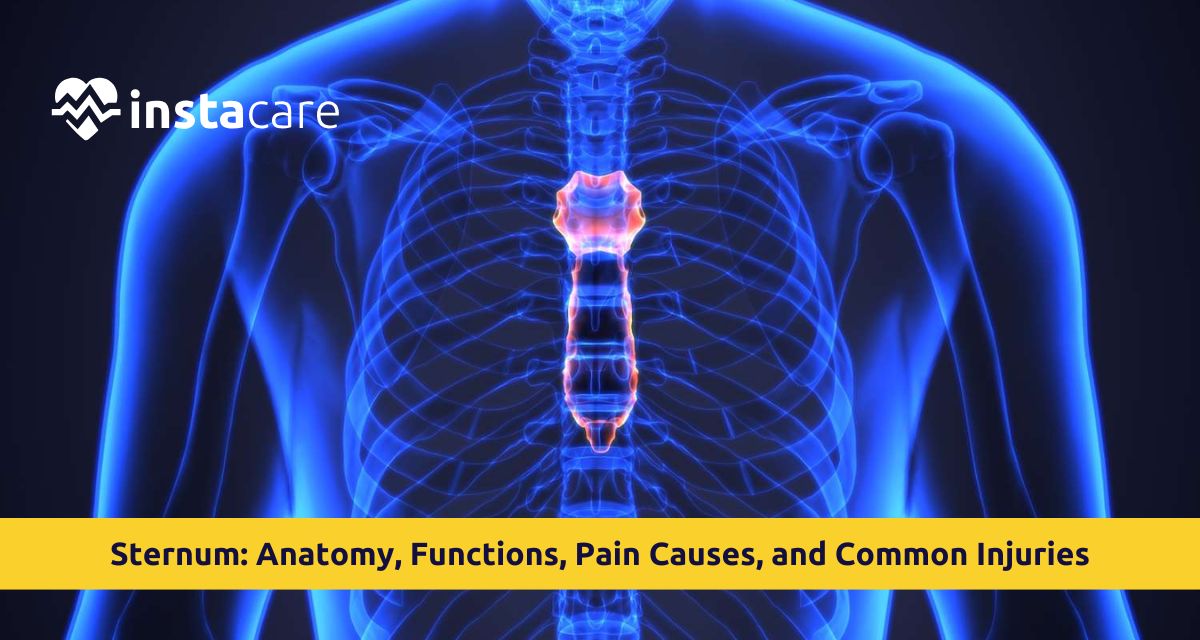If you experience sternum pain, suspect fractured sternum, or wish to learn more about your chest bone, the article below is a description of anatomy, sternum functions, potential injury, and successful treatment in connection with the sternum.
What Is the Sternum?
The sternum is a flat, slender bone in the chest, running down the middle. It's also known as the bone that you feel running down the center of your chest, between ribs. The sternum is an anatomical component of the thoracic skeleton and articulates the rib bones with the costal cartilage. It serves as an anchor for certain ribs and is the support of the chest wall. sternum vs breastbone anatomically are the same thing, but "sternum" is the correct term and "breastbone" is the common name.
Anatomy of the Sternum
Sternum anatomy contains layers that consist of three major elements:
Manubrium
The highest portion, trapezoid in shape. It connects
clavicles (collarbones) and the first two ribs. Sternoclavicular joint is where clavicle is connected with the manubrium of sternum.
Body (Gladiolus)
Middle and longest portion. Here most of the ribs (3rd to 7th) are connected due to the assistance of cartilage.
Xiphoid Process
The small, pointed cartilage at the front, which ossifies later in years. Critical during CPR and at times may be mistaken for a sternum lump if bruised or swollen.
All these components provide structural support and enclose the heart and lungs.
Role of Sternum
The role of the sternum is more than to hold the chest together. It plays a significant function in:
- Shielding of inner organs, specifically the heart, lungs, and aorta.
- Stabilizing the rib cage on expanding and contracting of breathing.
- Attaching itself to clavicles, which anchor down the arm and shoulder movement.
- As a point of attachment for respiration and upper limb movement muscles.
Reasons of Sternum Pain
Sternum pain is alarming, in part because it's often mistaken for heart pain. But sternum pain causesbrange from harmless to severe injury.
Costochondritis
Inflammation of the costal cartilage and sternum joint. It produces a focal, sharp pain with specific aggravation with chest pressure.
Sternum Crack or Fracture
Sternum crack or fracture can occur due to car accidents, falls, or direct trauma during sports. It can result in severe pain and breathing difficulty.
Strained Muscle
Proper or repeated lifting straining muscles connected to the sternum results in soreness or dull pain.
Sternoclavicular Joint Inflammation
Sternoclavicular joint pain and inflammation can masquerade as the heart conditions and is usually caused by arthritis or trauma.
Respiratory Disease
Bronchitis, asthma, or pneumonia irritates tissue in front of the breastbone, which becomes painful when coughing or breathing deeply.
Anxiety and Stress
Anxiety tension clutches across the chest and is often confused with sternum pain.
Sternum Lump
A lump on the sternum could be an innocent cyst, lipoma, or less commonly, a tumour. Always see your doctor.
Sternum Injuries
Sternum Fracture
Ideally caused by trauma e.g. road traffic accident (especially seat belt). Presentation is acute chest pain, bruising, swelling, and pain on movement.
Cracked Sternum
Not such a bad break as a full fracture but otherwise tender. Possibly caused by chronic stress or blunt trauma.
Dislocated Sternoclavicular Joint
Dislocated sternum and clavicle, usually due to trauma or contact sports.
Injury to the Xiphoid Process
Can occur due to overriding stress over the lower sternum (e.g., improper CPR technique or blunt trauma). Pain worsens on bending or when recumbent.
Diagnosis of Sternum Pain
Proper diagnosis distinguishes the etiologies of sternum pain from cardiac disease. It is usually performed as follows:
Physical Examination and Medical History
Physicians will ask about recent traumas, exercise, or stress and palpate over the chest for tenderness.
Sternum X-ray
Sternum x-ray is used for the diagnosis of sternum fracture, cracks, or dislocations.
CT Scan or MRI
Provides greater detail in terms of soft tissues, joint inflammation, or potential tumors in the vicinity of the sternum.
Blood Tests
May be given to test for infection or inflammatory markers in case there is suspected infection or autoimmune disease.
Treatment Options for Sternum Pain
Treatment depends on the cause but typically encompasses the following:
Rest and Activity Modification
Rest and rest away from strenuous activities will heal when muscle strain or minor trauma is the cause.
Pain Relief Medications
NSAIDs like ibuprofen or acetaminophen might be consumed to reduce pain and swelling.
Ice and Heat Therapy
Icing for 15–20 minutes will reduce swelling, and heat will relieve spasms in constricted muscles.
Bracing
A binder or support can be used if there is a fractured sternum in an attempt to restrict motion and promote healing.
Physical Therapy
Symmetrical stretching and strengthening exercises restore motion without causing stiffness.
Surgical Intervention
Sometimes unavoidable but, if tumor, joint dislocation, or displaced fracture, then it will be unavoidable.
Treatment of Underlying Conditions
If pain is caused by costochondritis, infection, or
autoimmune illness, treatment of some sort like antibiotics or steroids will be required.
Prevention of pain in the sternum
The following are some of the practices that will lower your risk for sternum pain and sternum injury:
- Seat belt buckle up to avoid injury from car accidents.
- Lift and avoid overusing chest muscles.
- Pad the chest when engaging in high-impact activities with suitable equipment.
- Use good posture to minimize stress placed on the chest.
- Avoid tension and anxiety, which lead to contracting muscles across the chest.
Conclusion
Sternum or breastbone is an important structure in your chest that aids breathing, shields vital organs, and facilitates movement of the upper body. Although sternum ache is usually nothing to worry about, at other times it can indicate severe damage such as fractured sternum or dislocated joints.
Understanding sternum anatomy, how things work, and why pain in the sternum takes place will render you a force to be reckoned with in the event of discomfort or pain. With a fracture to the sternum, a swelling on the sternum, or unexplained chest pain, proper diagnosis and specific treatment are what cure.
Please book an appointment with the
Best Cardiologist in Lahore, Karachi, Islamabad, and all major cities of Pakistan through
InstaCare, or call our helpline at 03171777509 to find a verified doctor for your disease.

